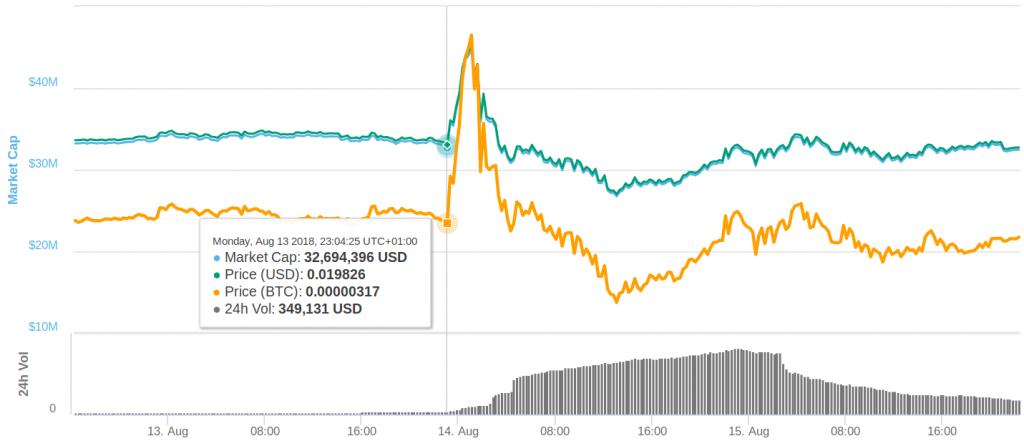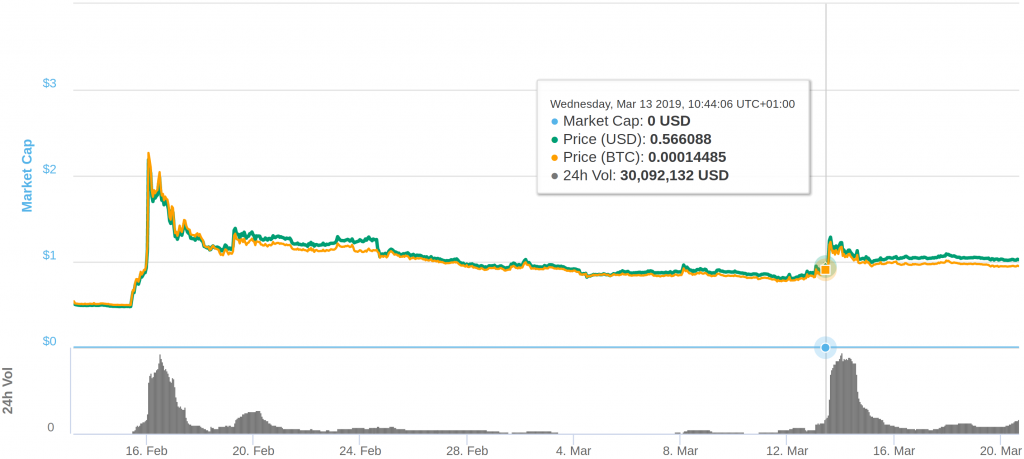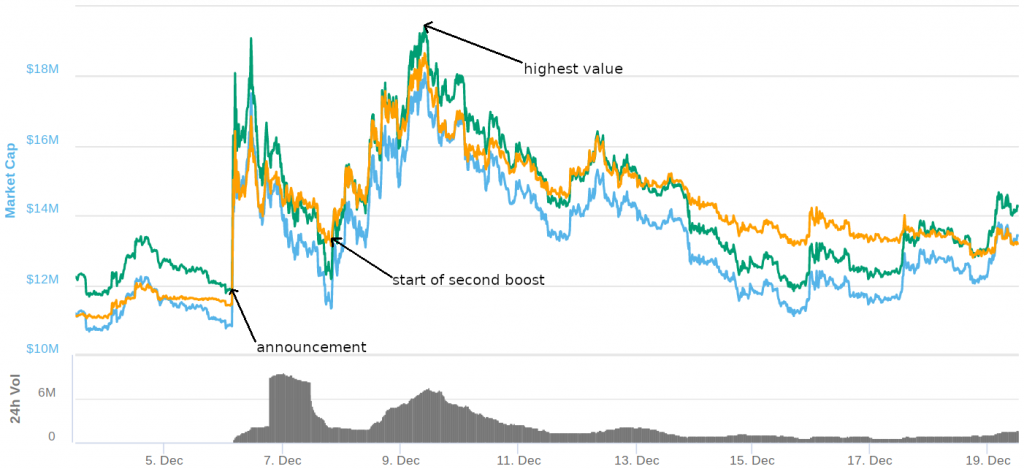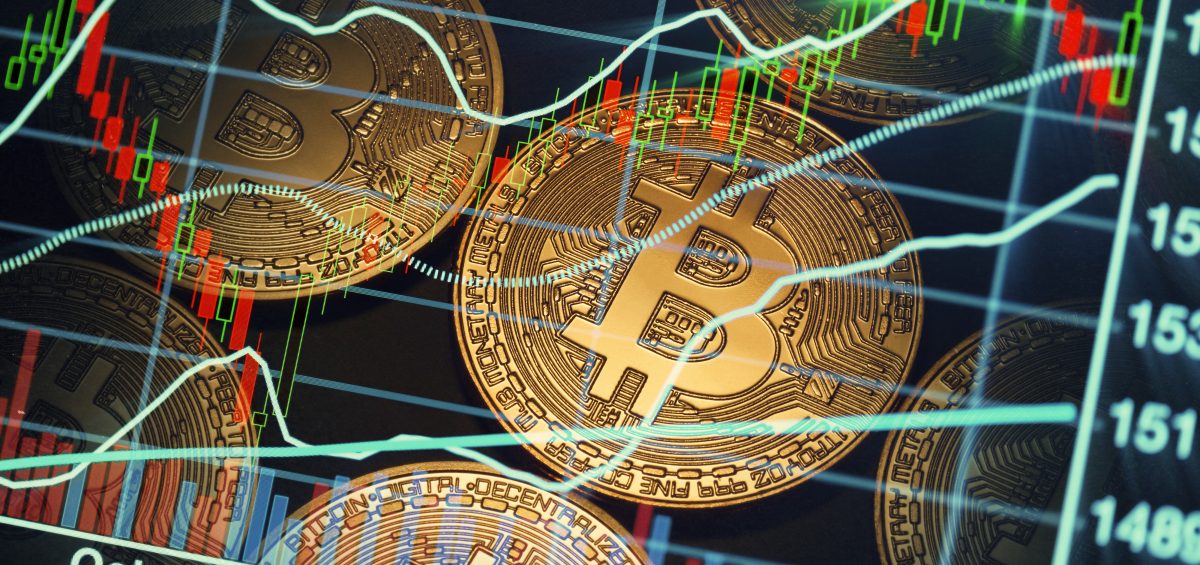Disclaimer: this article is not, in any way, investment advice. It is merely an analysis of one of the many potential factors which may be relevant to the rises and falls in the price of altcoins.
—
In economics, probably one of the biggest motivations and challenges is to predict how the market will behave, in order to make profitable investments. This is extremely hard in the stock market, and even more for cryptocurrencies.
It is well known that the crypto market is heavily influenced by the media and its popularity, as well as by the announcements the development teams make. However, there are a lot of variables involved, and finding and converting this information into data to be used by a model is a very lengthy and hard task.
There are some reports showing that the listings in the main exchange sites may lead to a boost in the price of the coins, and whenever this boost is very dramatic it is well covered by the crypto news. Last year it was also suggested that when Coinbase lists a new coin, the value of that coin greatly increases.
While this is a known effect, it would be good to know how often the listings affect the prices of coins, and how much. In this article we study the twelve most recent Binance listing announcements, and find that in nine of them there was an associated boost in the price. In some cases this boost is a pump and dump event, in others it extends in time; this might have less to do with the listing itself and more about other factors like announcements and media coverage of the company.
Ravencoin as a model example
Let us use Ravencoin as an initial example to potentially see hints of this listings effect. Consider the following plot showing the market cap in USD for Ravencoin, indicating three of the listings of this coin:
 Market cap (in USD) of RVN, with three influential listings marked. Market cap data from CoinMarketCap.
Market cap (in USD) of RVN, with three influential listings marked. Market cap data from CoinMarketCap.
Ravencoin is listed in many other websites, but we have chosen to show in the plot only these three as they seem to cause increasingly big consequences on the price. First, Bittrex is a big cryptocurrency exchange. Therefore, it is one of the candidates to consider in this study. As we can see in the plot, the listing seems to coincide with a peak in the price. This would imply that the listing is independent of this boost. However, if we take a closer look at that peak, we can see that it started shortly after 11 PM (UTC+1).
 Details of RVN’s market cap chart around Bittrex’s announcement. Taken from CoinMarketCap.
Details of RVN’s market cap chart around Bittrex’s announcement. Taken from CoinMarketCap.
As far as we are aware, Bittrex announced Ravencoin’s listing at around 11:12 PM (UTC+1). Therefore, since there do not seem to be any other public news regarding Ravencoin that day at that time, the plot above strongly suggests that Bittrex’s listing was a potential cause of the increase in price.
Binance is another one of the main exchange websites for cryptocurrency. According to CoinMarketCap it is the second biggest by trade volume, only behind OKEx. Since Ravencoin is not listed in OKEx, Binance is the biggest exchange where Ravencoin is listed. And at first sight it seems that Binance’s listing of RVN gave it a big boost in price. This seems like an interesting lead, and the price rise is so dramatic that this is the case we will study in this article.
Before we do that, consider the third listing exchange that we highlighted: Vertbase’s one. Vertbase is a small exchange which only supports six coins as of the time of writing this article. Therefore, it is a small exchange compared to the other ones. However, shortly after listing Ravencoin the currency saw its biggest increase in the price of all its life.
There are two options here: either it is a coincidence, and Vertbose’s listing did not have anything to do with this, or there is something special about that exchange. The first possibility cannot be discarded, as cryptocurrency markets are highly volatile and there is not a clear set of elements which determine the prices. There is however something special about Vertbase’s listing: it was the first exchange to offer the USD/RVN exchange.
Just like it seems plausible that a cryptocurrency being added to one of the main exchanges may affect its price, the same could hold for the first listing which allows direct trading with a fiat currency. The fact that a coin can be exchanged directly for dollars might cause more investors to trade with that coin, and this increased demand could translate into a price increase.
All these factors seem to align for Ravencoin’s listing in Vertbase, but more research needs to be done in order to confidently state this. Also this was a very extreme case, which was well covered within the crypto media (see, for instance, this article); it may not be the norm. However, checking how the listings which include for the first time USD for different cryptocurrencies seems like a promising lead, which would be interesting to explore further.
As we said above, we do not follow this line of thought in this article, and instead we check how Binance’s listing has affected the price of different altcoins.
Binance’s effect
For this study we consider the twelve most recent new listings that Binance has announced. We skip the stablecoins USDC and USDS as, as their name indicates, the whole point of those tokens is to not vary in price. Therefore the listings should be (and seem to be) irrelevant to its price.
To collect the data for the announcements and the actual listing times we used mainly two sources. After comparing most of Binance’s social media posts we have seen that most of the announcements are made at the same time. In the cases in this article where we use the exact announcement time we will consider the time when Binance tweeted the announcement. For the listing itself, Binance provides the exact time in the announcements.
For the financial data we use CoinMarketCap throughout this article. The historical data is given in USD, so that is the currency we use for the study. Also, it is given daily. The parameters that we use are opening (day) price, closing (day) price and highest (day) price. The coins for which we conduct the analysis are Ardor (ARDR), Cosmos (ATOM), Decred (DCR), Dent (DENT), Dock (DOCK), GoChain (GO), Selfkey (KEY), Mitrhil (MITH), Nebulas (NAS), Ontology Gas (ONG), Ren (REN) and Ravencoin (RVN). Let us have a first look at how Binance’s listing affected each coin’s value in USD:
 Highest day price for the twelve coins. The red arrow indicates Binance’s announcement of the listing. Price data from CoinMarketCap.
Highest day price for the twelve coins. The red arrow indicates Binance’s announcement of the listing. Price data from CoinMarketCap.
The red arrow indicates the moment when Binance tweeted about the new listings, and the plot represents the maximum value in USD that currency had everyday. At a first glance, it seems that the listings do cause the value of the coin to go up, at least momentarily. Notice that the arrow is always in a peak, but that is because the frequency of the data we use; we have a data point for every day, not for every few minutes.
If we have a closer look, just like we did with Ravencoin at the beginning, we can see that the peak starts shortly after the announcement of the new listing. Also, and again at a first glance, Mithril and Nebulas might have not been affected by the listing, or the effect was of the same order as the currency fluctuations around that date.
Let us now try to make things a bit more precise.
Daily boost
First let us have a look at the difference in value between the opening price for the coin at that day, and the highest value it achieved that same day. We define this quantity as daily boost, and give it as a percentage. We give all the values in the following table.
| Coin | Daily boost | Duration (days) |
|---|---|---|
| ardr | 59% | 2 |
| atom | 49% | 2 |
| dcr | 40% | 2 |
| dent | 185% | 7 |
| dock | 65% | 1 |
| go | 19% | – |
| key | 71% | 1 |
| mith | 12% | – |
| nas | 18% | – |
| ong | 169% | 4* |
| ren | 62% | 1 |
| rvn | 59% | 1 |
First of all, we do not consider any daily boost smaller than 30% to be significant. While the medians for the daily variation of the value for most coins are around 3% to 5%, daily variations of a 20% are not that rare, as can be inferred from the plots provided in our introduction to blockchain post after analysing the data for more coins. Furthermore, we do not consider changes of less than a 10% on top of that to be significant in this kind of market.
This excludes Mithril, Nebulas and GoChain from having a daily boost. A small local boost can still be seen in all of them, but we do not consider it either big enough or different enough from the variations around that date (as would be the case of GoChain) to consider it relevant. For all the other coins though there is a noticeable change in the price.
It is worth noting that for the three coins without a daily boost the 24h trading volume did not change significantly with the announcement, or this change was not significant with respect to the surrounding variations. However, in all the other cases the announcement and the daily boost are closely connected to a huge rise in the 24h volume. Since cryptocurrencies’ value oscillates only by offer and demand, the trading volume is obviously one of the main factors that contribute to it.
It is also interesting to see how long the effects of this daily boost last for. To calculate this, we check what day the closing price stabilises again, i.e., when the closing price is again the opening price of the day the announcement was made, with a 30% margin. As we can see, this boost typically lasts for one or two days, that is, it is very short lived.
There are two exceptions to this: Dent and Ontology Gas. For Dent this rise lasts for a week; for Ontology Gas the price in USD dollars is still significantly higher (in USD) than the price before the announcement. However, being Ontology Gas a token which is not even a year old, it is likely that other factors contributed to its increase in value again shortly after this listing. For example, a giveaway was announced on March 13th, which is likely to have caused the boost in price that same day, as we can see in the token’s price chart:
 Price chart for Ontology Gas around the time of Binance’s listing. Taken from CoinMarketCap.
Price chart for Ontology Gas around the time of Binance’s listing. Taken from CoinMarketCap.
Therefore, in this case we have given the boost a duration of four days, which is when the price decreased again (even though it stayed at a considerably higher value than before). Interestingly, the March 13th announcement was also made through Binance, and so the effect of this other boost might not be independent from Binance. However investigating this goes beyond the scope of this article.
In any case, the data strongly suggests that the initial boost of the coins after the listing announcement is a pump and dump event, as the boost starts to die away shortly after the actual exchange goes live in Binance. This delay is of just a couple of hours generally, except for the two biggest daily boosts. For Dent this delay is of 15 hours, while for Ontology Gas it is of 10 hours.
Longer pumps in price
Now, nine out of the twelve coins we consider have a significant daily boost on the day of the announcement. However there is a lot of variability with what happened with the coin’s value afterwards. Obviously there are many other factors that come into play here, so this is not surprising.
If we look at Dent or Ardor, we see that this boost is very narrow. However, in some other cases, like Selfkey or Ravencoin, the boost seems to last longer or even lead to an even bigger boost shortly after. This is our motivation to check which day the price of the coin returns to its opening price on the day of the announcement, within a certain margin.
For this margin we have decided to take the median of the daily variations of the coin. The median gives us an idea of typical variations for that currency, and so we think that it is a fair amount to consider as a base oscillation. We will call long boost to the maximum value of the coin during the period where it stabilises again to its value prior to announcement. Analogous to the daily boost, we include a table with the percent variation (increase) in value of the coin and the duration of this long boost.
| Coin | Long boost | Duration (days) |
|---|---|---|
| ardr | 59% | 6 |
| atom | 62% | 12* |
| dcr | 40% | 9 |
| dent | 185% | 15 |
| dock | 65% | 2 |
| key | 540% | 45 |
| ong | 527% | 17* |
| ren | 99% | 11 |
| rvn | 391% | 56 |
With this new boost we see that for Ren, Ontology Gas, Cosmos, and especially for Selfkey and Ravencoin, the effect of Binance’s listing might have had a much greater impact that extended many days in time after the initial boost.
For the long boost duration there are two special cases which we have considered separately, Cosmos and Ontology Gas. As before, for Ontology Gas there are other effects which come into play. So, in this case we have given the boost a length of seventeen days, which is the number obtained after a simple linear regression taking the decreasing trend the coin had between Binance’s listing and the aforementioned giveaway.
For Cosmos we have looked at the more fine data from CoinMarketCap, and have chosen a day where the value dropped within our desired range (notice that if we had used BTC as the currency to compare its value to, the boost would have finished around that date as well).
It is worth noting that Ravencoin, Ren and Selfkey’s big boost arrived a few days after the actual announcement and listing. Have a look for instance at Ren’s chart:
 Price chart for Ren around the time of Binance’s listing. Taken from CoinMarketCap.
Price chart for Ren around the time of Binance’s listing. Taken from CoinMarketCap.
We could argue that a big volume of announcements, tweets and news were responsible for these delayed boosts. However we could find similar amounts of information for the other listings where this delayed boost did not happen. Therefore, without further study these news cannot be used as the cause for the extra pump.
As we said above, this market is very volatile and very susceptible to news. The fear of missing out (FOMO) is an undeniable factor, and certainly news strongly influence this fear. While there might be a transition point in the volume of news about a certain coin which causes a big chain reaction which translates into one of this big delayed boosts, collecting all the data is not an easy task.
In any case, and as was expected, we have found strong evidence suggesting that Binance has a relevant effect in the price of coins with its listing announcements. Therefore, it is expected that most of the major exchanges will cause similar effects to the price of coins. There are also records of the opposite: being delisted translates into a loss of volume transaction, which causes the value of a coin to greatly drop in price. As we mentioned above, it would also be very interesting to see whether the introduction of the USD exchange has a strong effect in the value of a coin.





Leave a Comment